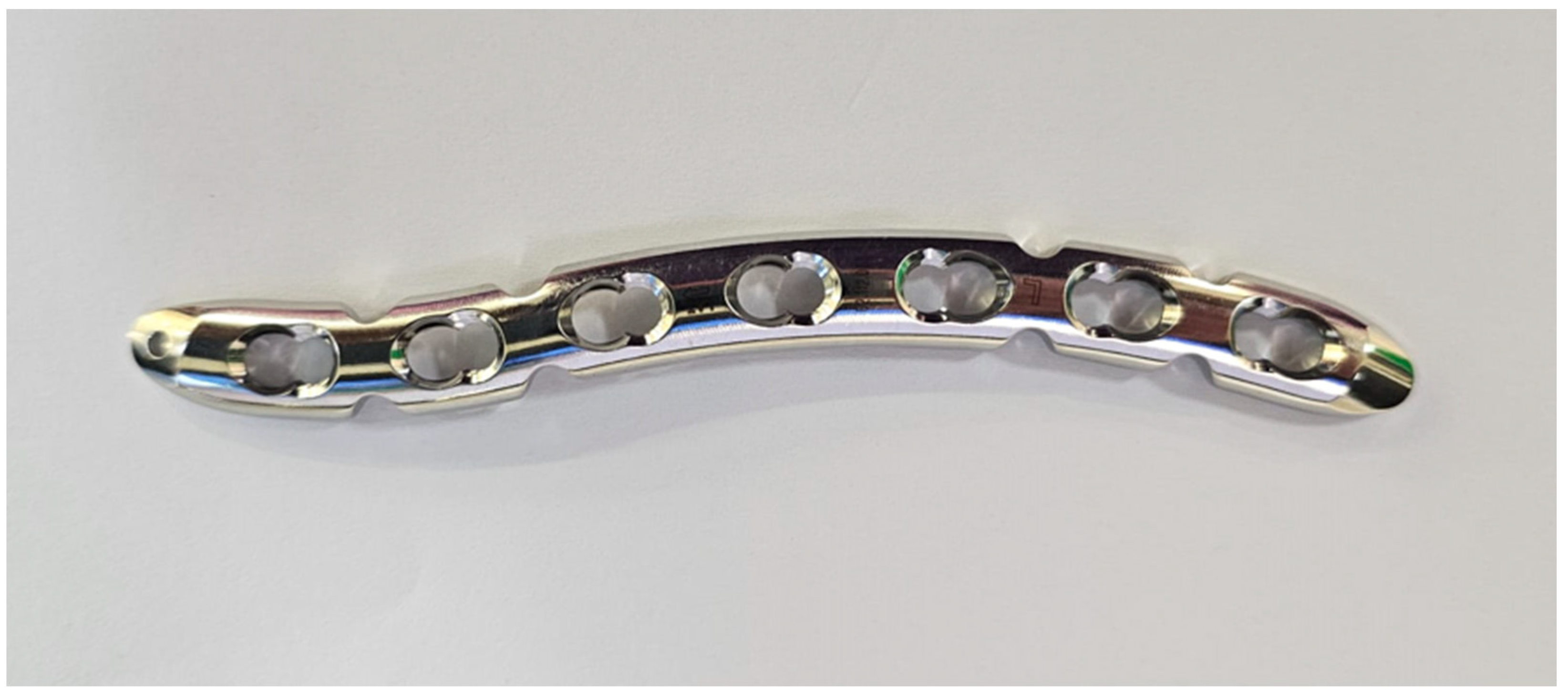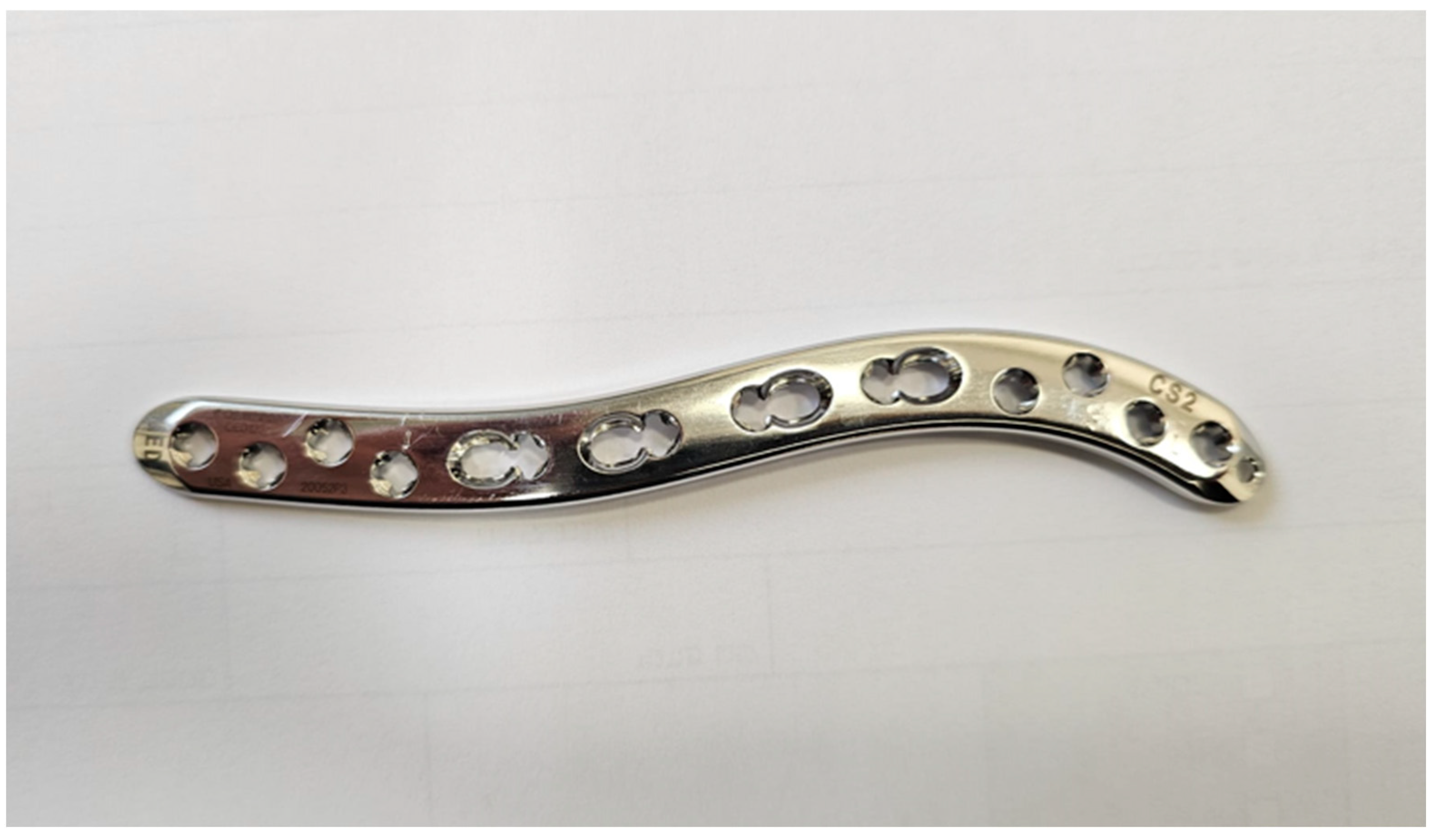Have New Plate Designs Reduced the Rate of Hardware Removal Following Midshaft Clavicle Fracture Fixation?
Abstract
1. Introduction
2. Patients and Methods
2.1. Surgical Technique
2.2. Statistical Methods
3. Results
4. Discussion
5. Conclusions
Author Contributions
Funding
Institutional Review Board Statement
Informed Consent Statement
Data Availability Statement
Conflicts of Interest
References
- Amer, K.; Smith, B.; Thomson, J.E.; Congiusta, D.; Reilly, M.C.; Sirkin, M.S.; Adams, M.R. Operative Versus Nonoperative Outcomes of Middle-Third Clavicle Fractures: A Systematic Review and Meta-Analysis. J. Orthop. Trauma 2020, 34, e6–e13. [Google Scholar] [CrossRef]
- Liu, G.D.; Tong, S.L.; Ou, S.; Zhou, L.S.; Fei, J.; Nan, G.X.; Gu, J.W. Operative versus non-operative treatment for clavicle fracture: A meta-analysis. Int. Orthop. 2013, 37, 1495–1500. [Google Scholar] [CrossRef] [PubMed]
- Sassi, E.; Hannonen, J.; Serlo, W.; Sinikumpu, J.J. Increase in surgical fixation of pediatric midshaft clavicle fractures since 2008. BMC Musculoskelet. Disord. 2022, 23, 173. [Google Scholar] [CrossRef]
- Daruwalla, Z.J.; Courtis, P.; Fitzpatrick, C.; Fitzpatrick, D.; Mullett, H. Anatomic variation of the clavicle: A novel three-dimensional study. Clin. Anatomy 2010, 23, 199–209. [Google Scholar] [CrossRef] [PubMed]
- Huang, J.I.; Toogood, P.; Chen, M.R.; Wilber, J.H.; Cooperman, D.R. Clavicular anatomy and the applicability of precontoured plates. J. Bone Jt. Surg. Am. 2007, 89, 2260–2265. [Google Scholar] [CrossRef]
- Galdi, B.; Yoon, R.S.; Choung, E.W.; Reilly, M.C.; Sirkin, M.; Smith, W.R.; Liporace, F.A. Anteroinferior 2.7-mm Versus 3.5-mm Plating for AO/OTA Type B Clavicle Fractures: A Comparative Cohort Clinical Outcomes Study. J. Orthop. Trauma 2013, 27, 121–125. [Google Scholar] [CrossRef]
- Pulos, N.; Yoon, R.S.; Shetye, S.; Hast, M.W.; Liporace, F.; Donegan, D.J. Anteroinferior 2.7-mm versus 3.5-mm plating of the clavicle: A biomechanical study. Injury 2016, 47, 1642–1646. [Google Scholar] [CrossRef]
- DePuy Synthes. 2.7 MM VA LCPTM CLAVICLE SYSTEM|Products|DePuy Synthes. 2020. Available online: https://www.jnjmedtech.com/en-EMEA/product/variable-angle-lcp-clavicle-system (accessed on 18 February 2025).
- DePuy Synthes. DePuy Synthes Shape Verification Analysis—Thickness Segmental Plates. 05/04/2020. Windchill Document #0000290903. 2020. Available online: https://www.google.com/url?sa=t&rct=j&q=&esrc=s&source=web&cd=&ved=2ahUKEwip5c-UqcmPAxUYK_sDHdSfPRQQFnoECBsQAQ&url=https%3A%2F%2Fwww.jnjmedtech.com%2Fsystem%2Ffiles%2Fpdf%2F163060-221216_DSUS_EMEA_Clavicle_white_paper.pdf&usg=AOvVaw1d-nFT5675MwlE6VQjjvas&opi=89978449 (accessed on 4 September 2025).
- Wang, J.; Chidambaram, R.; Mok, D. Is removal of clavicle plate after fracture union necessary? Int. J. Shoulder Surg. 2011, 5, 85–89. [Google Scholar] [CrossRef][Green Version]
- Baltes, T.P.A.; Donders, J.C.E.; Kloen, P. What is the hardware removal rate after anteroinferior plating of the clavicle? A retrospective cohort study. J. Shoulder Elbow Surg. 2017, 26, 1838–1843. [Google Scholar] [CrossRef] [PubMed]
- Acklin, Y.P.; Bircher, A.; Morgenstern, M.; Richards, R.G.; Sommer, C. Benefits of hardware removal after plating. Injury 2018, 49, S91–S95. [Google Scholar] [CrossRef]
- DePuy Synthes Trauma. VA LCPTM Clavicle Plate. 2023. Available online: https://www.google.com/url?sa=t&rct=j&q=&esrc=s&source=web&cd=&ved=2ahUKEwip5c-UqcmPAxUYK_sDHdSfPRQQFnoECBoQAQ&url=https%3A%2F%2Fwww.jnjmedtech.com%2Fen-EMEA%2Fproduct%2Fvariable-angle-lcp-clavicle-system&usg=AOvVaw09mPHselp4zVXC4c9ybzAQ&opi=89978449 (accessed on 4 September 2025).
- Vancleef, S.; Herteleer, M.; Carette, Y.; Herijgers, P.; Duflou, J.R.; Nijs, S.; Sloten, J.V. Why off-the-shelf clavicle plates rarely fit: Anatomic analysis of the clavicle through statistical shape modeling. J. Shoulder Elbow Surg. 2019, 28, 631–638. [Google Scholar] [CrossRef] [PubMed]
- Malhas, A.M.; Skarparis, Y.G.; Sripada, S.; Soames, R.W.; Jariwala, A.C. How well do contoured superior midshaft clavicle plates fit the clavicle? A cadaveric study. J. Shoulder Elbow Surg. 2016, 25, 954–959. [Google Scholar] [CrossRef] [PubMed]
- Biomechanical Analysis of Four Augmented Fixations of Plate Osteosynthesis for Comminuted Mid Shaft Clavicle Fracture: A Finite Element Approach. Available online: https://www.spandidos-publications.com/10.3892/etm.2020.8898 (accessed on 14 August 2025).
- Wurm, M.; Zyskowski, M.; Greve, F.; Gersing, A.; Biberthaler, P.; Kirchhoff, C. Comparable Results Using 2.0-Mm vs. 3.5-Mm Screw Augmentation in Midshaft Clavicle Fractures: A 10-Year Experience. Eur. J. Med. Res. 2021, 26, 14. [Google Scholar] [CrossRef]
- Sangiorgio, A.; Previtali, D.; Oldrini, L.M.; Milev, S.R.; Filardo, G.; Candrian, C. Comparable results of superior vs antero-inferior plating for the treatment of displaced midshaft clavicle fractures. A comparative study. Injury 2024, 55, 111449. [Google Scholar] [CrossRef]
- Nathan, F.; Jeffrey, B. Superior Versus Anteroinferior Plating of Clavicle Fractures. Orthopedics 2013, 36, e898–e904. [Google Scholar] [CrossRef]
- Nourian, A.; Dhaliwal, S.; Vangala, S.; Vezeridis, P.S. Midshaft Fractures of the Clavicle: A Meta-analysis Comparing Surgical Fixation Using Anteroinferior Plating Versus Superior Plating. J. Orthop. Trauma 2017, 31, 461–467. [Google Scholar] [CrossRef] [PubMed]
- Czajka, C.M.; Kay, A.; Gary, J.L.; Prasarn, M.L.; Choo, A.M.; Munz, J.W.; Harvin, W.H.; Achor, T.S. Symptomatic Implant Removal Following Dual Mini-Fragment Plating for Clavicular Shaft Fractures. J. Orthop. Trauma 2017, 31, 236–240. [Google Scholar] [CrossRef]
- Chen, M.J.; DeBaun, M.R.; Salazar, B.P.; Lai, C.; Bishop, J.A.; Gardner, M.J. Safety and efficacy of using 2.4/2.4 mm and 2.0/2.4 mm dual mini-fragment plate combinations for fixation of displaced diaphyseal clavicle fractures. Injury 2020, 51, 647–650. [Google Scholar] [CrossRef]
- Kitzen, J.; Paulson, K.; Korley, R.; Duffy, P.; Martin, C.R.; Schneider, P.S. Biomechanical Evaluation of Different Plate Configurations for Midshaft Clavicle Fracture Fixation: Single Plating Compared with Dual Mini-Fragment Plating. JBJS Open Access 2022, 7, e21. [Google Scholar] [CrossRef]
- Meinberg, E.G.; Agel, J.; Roberts, C.S.; Karam, M.D.; Kellam, J.F. Fracture and Dislocation Classification Compendium—2018. J. Orthop. Trauma 2018, 32, S1–S10. [Google Scholar] [CrossRef]
- van der Meijden, O.A.; Houwert, R.M.; Hulsmans, M.; Wijdicks, F.-J.G.; Dijkgraaf, M.G.; Meylaerts, S.A.; Hammacher, E.R.; Verhofstad, M.H.; Verleisdonk, E.J. Operative treatment of dislocated midshaft clavicular fractures: Plate or intramedullary nail fixation? A randomized controlled trial. J. Bone Jt. Surg. Am. 2015, 97, 613–619. [Google Scholar] [CrossRef] [PubMed]
- King, P.R.; Lamberts, R.P. Management of clavicle shaft fractures with intramedullary devices: A narrative review. Expert Rev. Med. Devices 2020, 17, 807–815. [Google Scholar] [CrossRef] [PubMed]
- Hulsmans, M.H.J.; van Heijl, M.; Houwert, R.M.; Hammacher, E.R.; Meylaerts, S.A.G.; Verhofstad, M.H.J.; Dijkgraaf, M.G.W.; Verleisdonk, E.J.M.M. High Irritation and Removal Rates After Plate or Nail Fixation in Patients with Displaced Midshaft Clavicle Fractures. Clin. Orthop. Relat. Res. 2017, 475, 532–539. [Google Scholar] [CrossRef] [PubMed]
- Kumar, A.V.; Ramachandra Kamath, K.; Salian, P.R.V.; Krishnamurthy, S.L.; Annappa, R.; Keerthi, I. Operative stabilisation versus non-operative management of mid-shaft clavicle fractures. SICOT J. 2022, 8, 45. [Google Scholar] [CrossRef]
- Alzahrani, M.M.; Cota, A.; Alkhelaifi, K.; Aleidan, A.; Berry, G.; Reindl, R.; Harvey, E. Are Clinical Outcomes Affected by Type of Plate Used for Management of Mid-Shaft Clavicle Fractures? J. Orthop. Traumatol. 2018, 19, 8. [Google Scholar] [CrossRef]
- Ryan, P.M.; Wilson, C.; Volkmer, R.; Hisle, G.; Brennan, M.; Stahl, D. Low Rate of Secondary Surgery and Implant Removal Following Superior, Precontoured Plating of Midshaft Clavicle Fractures. Baylor Univ. Med. Cent. Proc. 2023, 36, 461–467. [Google Scholar] [CrossRef]
- Wijdicks, F.J.G.; Millett, P.J.; Houwert, R.M.; Van Der Meijden, O.A.J.; Verleisdonk, E.M. Systematic Review of the Complications of Plate Fixation of Clavicle Fractures. Arch. Orthop. Trauma Surg. 2012, 132, 617–625. [Google Scholar] [CrossRef]
- Van de Wall, B.J.M.; Diwersi, N.; Scheuble, L.; Lecoultre, Y.; Link, B.C.; Babst, R.; Beeres, F.J.P. Surgical Technique of Low-Profile Dual Plating for Midshaft Clavicle Fractures. Oper. Orthop. Traumatol. 2025, 1–6. [Google Scholar] [CrossRef]
- Vos, D.; Hanson, B.; Verhofstad, M. Implant removal of osteosynthesis: The Dutch practice. Results of a survey. J. Trauma Manag. Outcomes 2012, 6, 6. [Google Scholar] [CrossRef]
- Onche, I.I.; Osagie, O.E.; INuhu, S. Removal of orthopaedic implants: Indications, outcome and economic implications. J. West Afr. Coll. Surg. 2011, 1, 101–112. [Google Scholar]



| Group 1 (n = 184) | Group 2 (n = 67) | p-Value | |
|---|---|---|---|
| Age (SD) | 32.86 (13.64) | 32.14 (13.15) | 0.39 |
| Gender: | 0.75 | ||
| Female (n) | 16.85% (31) | 14.92% (10) | |
| Side of injury: | 0.47 | ||
| Left (n) | 51.63% (95) | 47.76% (32) | |
| Plate removal (n) | 20.1% (37) | 20.9% (14) | 0.86 |
| Mean days to removal (SD) | 331.5 (207.6) | 341.02 (114.3) | 0.83 |
| Type of fracture AO/OTA (n): | 0.86 | ||
| B1 | 41.85% (77) | 38.81% (26) | |
| B2 | 30.98% (57) | 34.32% (23) | |
| B3 | 27.17% (50) | 26.86% (18) | |
| Lag screw (SD) * | 0.62 (0.79) | 0.69 (0.75) | 0.56 |
| Group 1 (n = 37) | Group 2 (n = 14) | p-Value | |
|---|---|---|---|
| Age (SD) | 30.27 (12.51) | 28.28 (11.73) | 0.60 |
| Gender: | 0.56 | ||
| Female—(n) | 21.62% (8) | 14.28% (2) | |
| Side of injury: | 0.03 | ||
| Left—n | 10 | 14 | |
| Mean days to removal | 331.5 | 341.2 | 0.87 |
| Type of fracture AO: | 0.57 | ||
| B1 | 18 | 6 | |
| B2 | 11 | 3 | |
| B3 | 8 | 5 | |
| Lag screw (SD) * | 0.40 (0.64) | 0.57 (0.75) | 0.47 |
| Removal Reason | Total % | Group 1% | Group 2% | p-Value |
|---|---|---|---|---|
| Irritation | 32.7 | 38.9 | 15.4 | 0.12 |
| Pain | 22.4 | 25 | 15.4 | 0.70 |
| Hardware Prominence/Bulging | 16.3 | 8.3 | 38.5 | 0.02 |
| Nonunion | 6.1 | 5.6 | 7.7 | 1 |
| Infection | 4.1 | 5.6 | 0 | 1 |
| Limited Range of Motion | 4.1 | 2.8 | 7.7 | 0.49 |
| Other Reasons | 14.3 | 13.9 | 15.4 | 1 |
Disclaimer/Publisher’s Note: The statements, opinions and data contained in all publications are solely those of the individual author(s) and contributor(s) and not of MDPI and/or the editor(s). MDPI and/or the editor(s) disclaim responsibility for any injury to people or property resulting from any ideas, methods, instructions or products referred to in the content. |
© 2025 by the authors. Licensee MDPI, Basel, Switzerland. This article is an open access article distributed under the terms and conditions of the Creative Commons Attribution (CC BY) license (https://creativecommons.org/licenses/by/4.0/).
Share and Cite
Oulianski, M.; Weil, Y.; Ben Yehuda, O.; Mosheiff, R.; Jammal, M. Have New Plate Designs Reduced the Rate of Hardware Removal Following Midshaft Clavicle Fracture Fixation? J. Clin. Med. 2025, 14, 6351. https://doi.org/10.3390/jcm14186351
Oulianski M, Weil Y, Ben Yehuda O, Mosheiff R, Jammal M. Have New Plate Designs Reduced the Rate of Hardware Removal Following Midshaft Clavicle Fracture Fixation? Journal of Clinical Medicine. 2025; 14(18):6351. https://doi.org/10.3390/jcm14186351
Chicago/Turabian StyleOulianski, Maria, Yoram Weil, Omer Ben Yehuda, Rami Mosheiff, and Mahmoud Jammal. 2025. "Have New Plate Designs Reduced the Rate of Hardware Removal Following Midshaft Clavicle Fracture Fixation?" Journal of Clinical Medicine 14, no. 18: 6351. https://doi.org/10.3390/jcm14186351
APA StyleOulianski, M., Weil, Y., Ben Yehuda, O., Mosheiff, R., & Jammal, M. (2025). Have New Plate Designs Reduced the Rate of Hardware Removal Following Midshaft Clavicle Fracture Fixation? Journal of Clinical Medicine, 14(18), 6351. https://doi.org/10.3390/jcm14186351






